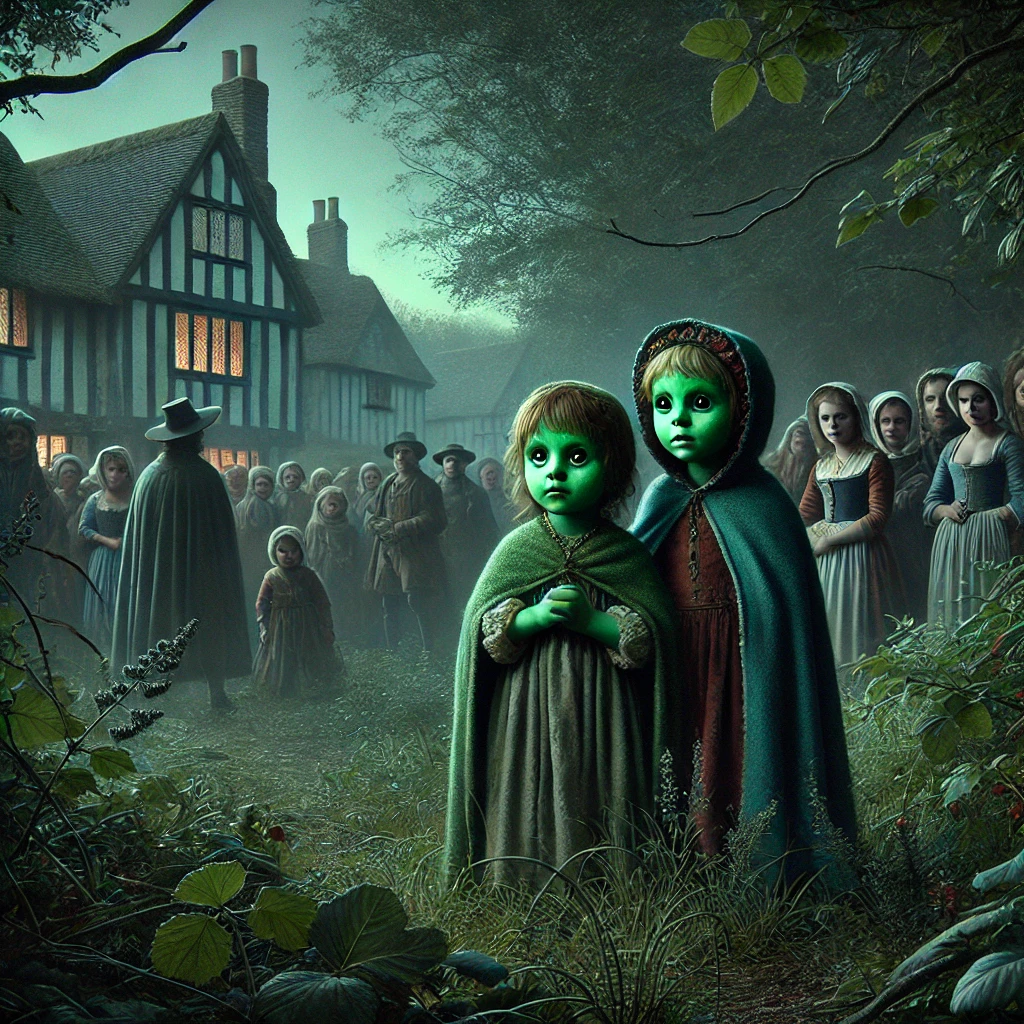The legend of the Green Children of Woolpit is one of the most fascinating stories to have emerged from medieval England. This tale, from the rural village of Woolpit in Suffolk, has captivated historians, folklorists, and other curious minds for centuries. A mysterious tale of mythology and history, the saga of the green-skinned siblings is to this day a tale that poses more questions than answers regarding its origin and meaning. In this article, we go deep into this enthralling legend on its narrative, interpretations, and lasting legacy.

Legend of the Green Children of Woolpit
The legend dates back to King Stephen or King Henry II in the 12th century. According to chroniclers Ralph of Coggeshall and William of Newburgh, it is said that two green-skinned children, a brother and sister, were found by the villagers of Woolpit. It is believed that the children were discovered near one of the wolf pits the villagers had dug into a deep trap with the purpose of catching wolves.
It was their unusual behavior and expressions in language, aside from having this incredible greenish-toned skin, that made these children strange. There were alarm and confusion when they brought the children home to Sir Richard de Calne, a local nobleman who tried his best to provide for them.
Life Adjustment of the Children at Woolpit

The green children refused all food initially, as if they were not familiar with this thing called eating. A few days down the line, they began accepting raw beans, which seemed familiar to them. Gradually, they started accepting local food, and as they adapted to it, their green skin turned out to be natural in complexion.
Unfortunately, the boy fell ill and died within a week of their arrival. The girl survived, learned English, and eventually told her tale, which only added to the enigma.
The Green Girl’s Explanation
She described her home as a place cut off from this world by a great river. She and her brother, she said, had been watching over their father’s animals when they heard the jingling of bells.
Interpretations of the Green Children of Woolpit
In the course of time, the legend of the green children has been used to feed a multitude of interpretations, ranging from plausible historical theorizing to fanciful speculation.
1. Folklore and Mythology
Most scholars believe that this is a medieval folktale, which is full of symbolism. The green skin can be interpreted as referring to supernatural creatures or fairy folk, which also recurs within the context of Celtic mythology: beings living in parallel worlds. The phrase “St. Martin’s Land” and the eternal twilight might represent liminality-a space between what is known and what is not.
2. A Historical Perspective
Other historians propose that the green children were Flemish migrants whose flight was forced by political violence. Owing to their persecution during the 12th century, it was impossible that the migrants of Flemish settlers in England not be maltreated. Again, the skin of the children could be explained by the chlorosis, the anemia type caused by a poor diet. In such a way, the kids’ ability to look different and fragile may be explained by this explanation.
This could just be because of their Flemish origin; the “homeland” might have been a place of twilight; perhaps it was only the childish recollection of what used to be their life under dark forests or shaded areas.
3. Extraterrestrial Theories
Modern readings often get into science fiction. Others believe that the green children were aliens who entered Earth accidentally through some kind of scientific portal or wormhole. The new language, the green skin and the strange clothes are all part of this fantastic explanation. As this account seems quite impossible, it remains one of the fascinating versions brought to light by theorists of conspiracy and UFO sightings.
4. Religious Symbolism
The mention of St. Martin, patron saint of acts of charity and humility, would incline the reader to read such a tale as a religious lesson, and the journey of the green children might be construed as spiritual awakening, transformation, or redemption. Their final assimilation into the local community could be seen as a victory of faith and charity over the forces of fear and ignorance.
Legacy of the Green Children of Woolpit

The green children have left a lasting impression on Woolpit’s cultural heritage. Even its name, derived from “wolf pits,” does seem to embrace the mystique of its past. Visitors to Woolpit are able to stroll among and view its ancient landmarks. Among these are to be counted the church of St. Mary and its origins date back to the medieval period when legend has it originated.
Their story has also inspired various works of art, literature, and other forms of media. The green children’s tale continues to be told through different forms such as novels and plays, scholarly studies, and even podcasts. The legend has been rewritten and reimagined in various forms such that every interpretation gives rise to a new layer of mystery.
What can we learn from the Legend?
At its root, therefore, the green children of Woolpit remind one of mankind’s long-felt fascination with the unknown be it folklore, history, or science fiction. It is that way the story goes and challenges our perceptions of reality and encourages us to live with the mystery of existence.
And similarly, the tale of the green children, from an intergalactic visitation to social integration in their village, becomes a metaphor for acceptance and adaptation to the societal values of their new community. As we are in many cases divided in terms of our natural differences, acceptance of the unfamiliar and exploration of common ground is what the story will bring out to us.
Conclusion
The legend of The Green Children of Woolpit stands alive across the centuries, still capable of being fascinating and inspiring. Whether it’s a history, folklore, or mere imagination, the story has deep words to say about human curiosity and ability to adapt in the realm of imagination. With each new generation opening the pages to read this story, the green children will forever be an icon for the power of mystery that never runs dry and the quest for knowledge that could go on until time runs out.
By holding onto these subtleties of this story and absorbing its many meanings, we simultaneously keep the legend alive and enhance our understanding of human experience.









